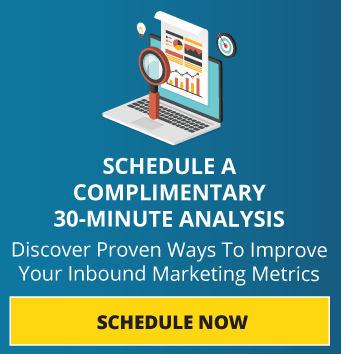
The Most Important Sales and Marketing Metrics On The Planet
Focus On Just A Few Numbers And You Will Make A Bigger Impact
 Everyone is talking about marketing metrics, sales metrics, dashboards, analytics, data and the insights that come along with them.
Everyone is talking about marketing metrics, sales metrics, dashboards, analytics, data and the insights that come along with them.
All the hoopla aside, they are critical for getting your revenue generation dialed in and building the scalable, repeatable and predictable revenue generation machine everyone is so desperately searching for.
When it comes to getting started looking at the numbers and the data, our best advice is to start slowly and pick a handful of important metrics. These metrics should be easy to track and, more importantly, give you valuable insights that you can act on to improve overall performance quickly and without breaking the bank.
Here are the handful of important marketing metrics and sales metrics that you should have a handle on right now and what they should be telling you about your own revenue efforts.
Site-Wide Conversion Rate
Of all the anonymous visitors on your site, what percentage are converting into inquires? That’s site-wide conversion rate. If 1,000 people visit your site in January and 100 give you their contact information, you have a site-wide conversion rate of 10%.
Typically, websites have site-wide conversion rates between 1% and 3%, but we find fewer “typical” websites these days. We have clients with 15% site-wide conversion rates. We have other clients that struggle to push up over 1%, but their visitor traffic is so high that they still generate a ton of leads. Instead of worrying about typical rates, just get your number and work to make it better month over month.
If your site-wide conversion rate is lower than you’d like, start by looking at the conversion points on your site. Do you have enough educational content? Is that content strategically placed? Is it delivered in context (for example, having metrics offers on metrics pages)? Do you have offers for people at all stages of the buyer journey? Do you have offers for all of your target personas? If you can’t answer these questions positively, that’s a great place to start looking for improvement ideas.
Close Rate On Proposals/Agreements
 If you want to see revenue improvement, the bottom of the funnel is a great place to start. If you close 50% of the proposals you submit, improving that to 60% (which isn’t that hard) is going to drive a big increase in revenue. If you only close 10%, getting that to 30% is going to drive even more revenue. Remember your prioritization methodology. When it comes to sales and marketing upgrades, look for places where you can make a big impact for the least amount of effort. This is one of those places.
If you want to see revenue improvement, the bottom of the funnel is a great place to start. If you close 50% of the proposals you submit, improving that to 60% (which isn’t that hard) is going to drive a big increase in revenue. If you only close 10%, getting that to 30% is going to drive even more revenue. Remember your prioritization methodology. When it comes to sales and marketing upgrades, look for places where you can make a big impact for the least amount of effort. This is one of those places.
Start by looking at the documentation you’re providing. Look at the meeting or calls that go along with the proposal submission or proposal reviews. You should probably have about an 80% to 90% close rate on proposals submitted. The big mistake people typically make is rushing to submit before they truly know enough about the prospect to do a great job. We don’t even give recommendations to prospects until we have a commitment that we’re going to be working together. You want to consider something similar for your business.
Percentage Of Sales Opportunities From Leads Generated
You might be generating a ton of leads, but if they don’t turn into sales opportunities, those leads are not worth much and you’re basically generating the wrong type of leads. This metric gives you a good idea of the lead quality. Having fewer high-quality leads is always better than having a lot of low-quality leads.
Knowing the percentage of sales opportunities (as qualified by the sales team) from your total leads generated lets you know how well your marketing is doing at creating quality leads. Typically, around 30% to 40% of all leads should be quality leads, meaning they score high in your lead scoring model (which usually reflects attribution around behavior, demographic or even psychographic characteristics of the person).
Of those quality leads, about 60% should be turning into sales opportunities. Remember, some high-quality leads might not be ready to buy, which makes them high quality but not quite yet sales opportunities. Those leads need additional nurturing before they’re ready to engage in active sales cycles.
Leads From Organic Visitors
 Your prospects are searching Google, Yahoo and Bing for your products and services right now. You’re competing with your top competitors for those eyeballs. The better you rank on those search engines, the more people will end up on your site and eventually in your sales cycle. You need to know how many leads are coming from searches like this.
Your prospects are searching Google, Yahoo and Bing for your products and services right now. You’re competing with your top competitors for those eyeballs. The better you rank on those search engines, the more people will end up on your site and eventually in your sales cycle. You need to know how many leads are coming from searches like this.
Google is so integral to how people buy today that you need to be aware not of what words you rank for but of how many people are coming to your site from those words. If each month more and more people are coming to your site from organic searches, your marketing is executing effectively. We’re not talking about paid ads, just organic search visitors.
One way to improve your rankings is to make sure you have high-quality pages on your website. Pages that people share, click on and download items from are all good and solid signals to Google that these quality pages. That means Google is likely to move you up in the rankings.
Length Of The Sales Cycle
The faster your sales cycle, the faster you’ll generate revenue. Knowing how long it takes on average to close a new customer is critical. If your sales cycle is 55 days, working to get that down to 45 days will have a major impact on your business. In fact, it’s almost like getting an extra two months at the end of the year.
To shorten the sales cycle, identify areas where the process bogs down. Perhaps your agreement is too legal heavy and it takes two weeks for the prospect to meet with their legal counsel to review it. If you took out some of the legal details, you might be able to take two weeks off the back end of the sales cycle.
If every prospect wants to talk to references, finding a way to make that process simpler would shorten the sales cycle. We typically provide video reference reels. These work wonders in removing the back and forth associated with getting, giving and managing references. When you send this proactively, you can eliminate the entire reference conversation.
As part of our engagement with clients, we keep an eye on so many more metrics. We know that it can be overwhelming, but the key to staying ahead is to start slow and gain momentum over time. The five metrics highlighted here will shine a light on your sales and marketing efforts, so you’ll be able to move forward positively in a short amount of time. Focusing on these areas is going to help you improve your ability to generate leads, close leads and hit (or even exceed) your revenue goals.
Once you get comfortable with these numbers, start looking at dashboards to consolidate like metrics and gain access to the bigger picture, where metrics are reviewed in context to other metrics. This is where a lot of insights are derived. Bigger, more strategic analysis can produce bigger, more strategic insights that influence messaging, prospect targeting, content strategy and your sales process.
The key is to not be intimidated by the numbers. Get started and you’ll see the improvements that keep you engaged and excited.
Square 2 Marketing – Revenue Is Earned Through Experience, Methodology And Insights!

CEO and Chief Revenue Scientist
Mike Lieberman, CEO and Chief Revenue Scientist
Eliminate Hit-or-Miss Marketing Moves
Get advice, tips, tools and guidance to generate more leads for your company in this weekly email newsletter.



Eliminate Hit-or-Miss Marketing Moves
Get advice, tips, tools and guidance to generate more leads for your company in this weekly email newsletter.













